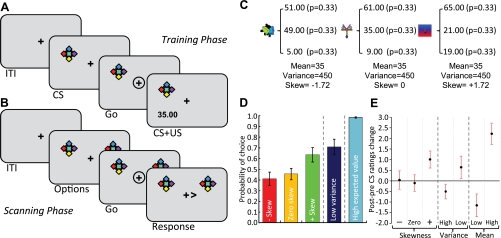Fig. 1.
Experimental design and behavioral results. A: conditioning task. Outside the scanner participants engaged in a conditioning task. Abstract visual stimuli were presented on the left or right side of the screen, and participants were required to indicate the side with left or right key presses to view the associated outcomes. B: scanning task. Inside the scanner the stimuli were presented on the left and right sides of the screen, and participants were required to make a button press to indicate attention. In this example trial, the two stimuli on each side of the screen are the same. Occasionally different stimuli were displayed on each side of the screen, requiring participants to make a choice using left or right button presses (with index and middle finger of the right hand). C: examples of stimuli and reward distributions. The 3 lotteries of interest differed in skewness but had the same variance and mean. Each lottery could generate one of 3 equiprobable outcomes on each trial. Stimuli were randomly assigned to each distribution for each participant. D: behavioral preference on choice trials. On average participants preferred stimuli predicting positively skewed reward distributions over negatively skewed distributions, low variance over high variance, and high mean over low mean. E: pre- and postexperiment stimuli pleasantness ratings. The change in pleasantness ratings for the abstract visual stimuli reflected participants' behavior on choice trials. ITI, intertrial interval. CS, conditioned stimulus; US, unconditioned stimulus.

